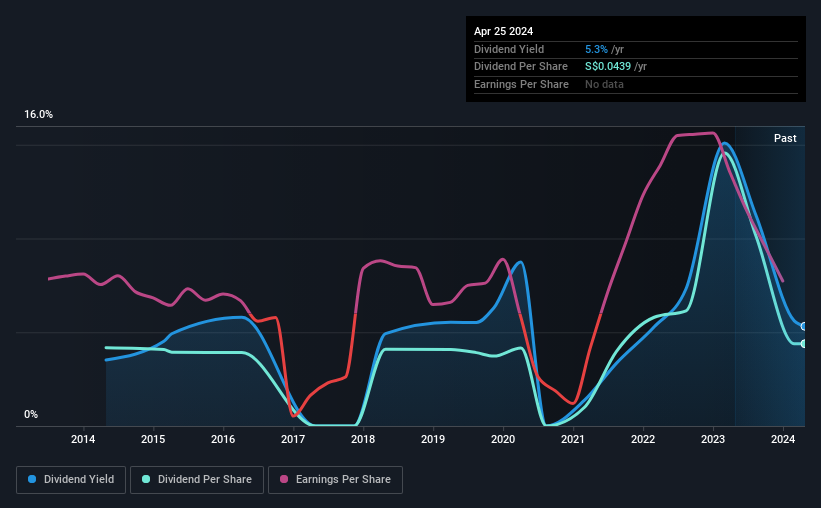Uni-Asia Group (SGX:CHJ) Is Due To Pay A Dividend Of $0.022
The board of Uni-Asia Group Limited (SGX:CHJ) has announced that it will pay a dividend on the 31st of May, with investors receiving $0.022 per share. The dividend yield of 5.3% is still a nice boost to shareholder returns, despite the cut.
Check out our latest analysis for Uni-Asia Group
Uni-Asia Group's Payment Has Solid Earnings Coverage
A big dividend yield for a few years doesn't mean much if it can't be sustained. Based on the last payment, Uni-Asia Group was quite comfortably earning enough to cover the dividend. This means that a large portion of its earnings are being retained to grow the business.
If the trend of the last few years continues, EPS will grow by 29.5% over the next 12 months. If the dividend continues on this path, the payout ratio could be 56% by next year, which we think can be pretty sustainable going forward.
Dividend Volatility
Although the company has a long dividend history, it has been cut at least once in the last 10 years. Since 2014, the dividend has gone from $0.0306 total annually to $0.0322. Dividend payments have grown at less than 1% a year over this period. It's encouraging to see some dividend growth, but the dividend has been cut at least once, and the size of the cut would eliminate most of the growth anyway, which makes this less attractive as an income investment.
The Dividend Looks Likely To Grow
Given that the dividend has been cut in the past, we need to check if earnings are growing and if that might lead to stronger dividends in the future. It's encouraging to see that Uni-Asia Group has been growing its earnings per share at 29% a year over the past five years. Uni-Asia Group is clearly able to grow rapidly while still returning cash to shareholders, positioning it to become a strong dividend payer in the future.
Uni-Asia Group Looks Like A Great Dividend Stock
In general, we don't like to see the dividend being cut, especially when the company has such high potential like Uni-Asia Group does. Reducing the amount it is paying as a dividend can protect the company's balance sheet, keeping the dividend sustainable for longer. All of these factors considered, we think this has solid potential as a dividend stock.
Investors generally tend to favour companies with a consistent, stable dividend policy as opposed to those operating an irregular one. Still, investors need to consider a host of other factors, apart from dividend payments, when analysing a company. As an example, we've identified 4 warning signs for Uni-Asia Group that you should be aware of before investing. Looking for more high-yielding dividend ideas? Try our collection of strong dividend payers.
Have feedback on this article? Concerned about the content? Get in touch with us directly. Alternatively, email editorial-team (at) simplywallst.com.
This article by Simply Wall St is general in nature. We provide commentary based on historical data and analyst forecasts only using an unbiased methodology and our articles are not intended to be financial advice. It does not constitute a recommendation to buy or sell any stock, and does not take account of your objectives, or your financial situation. We aim to bring you long-term focused analysis driven by fundamental data. Note that our analysis may not factor in the latest price-sensitive company announcements or qualitative material. Simply Wall St has no position in any stocks mentioned.

 Yahoo Finance
Yahoo Finance 
